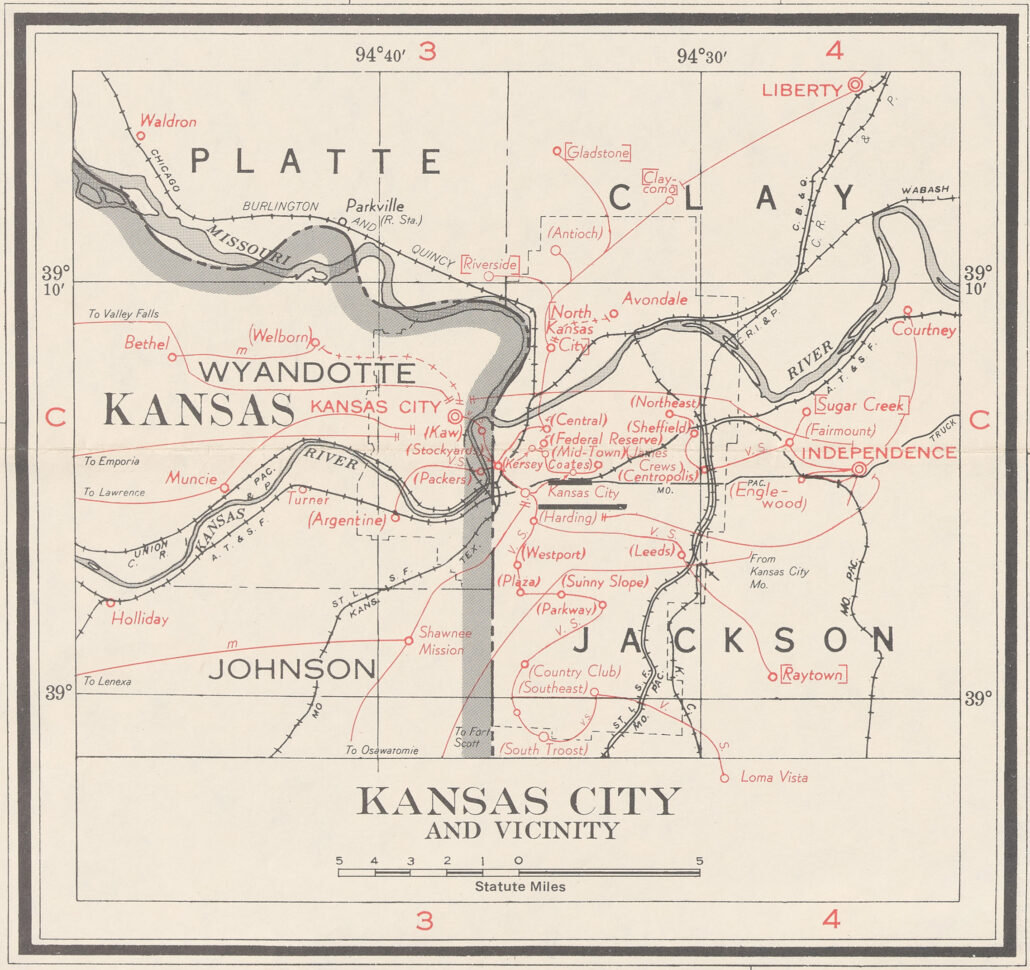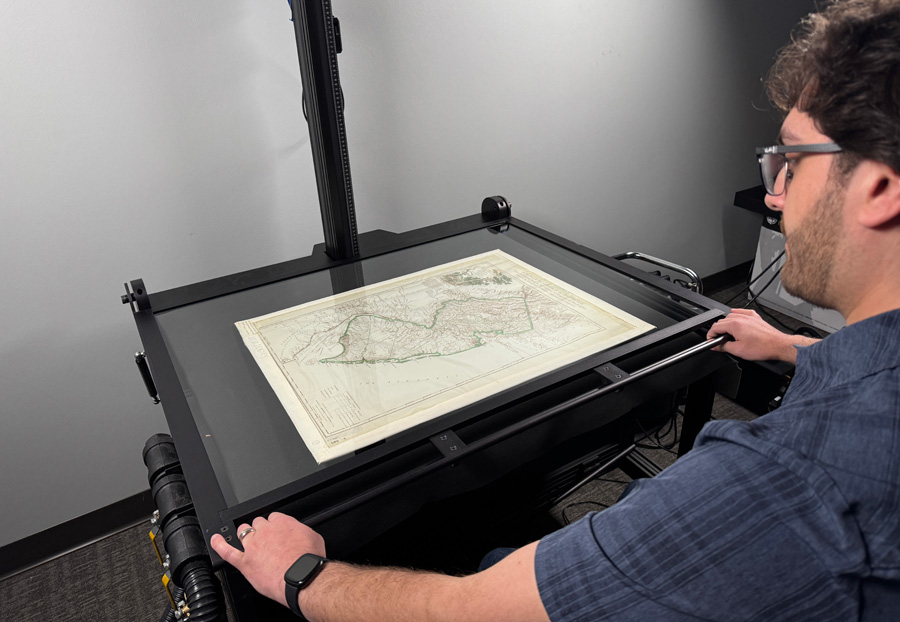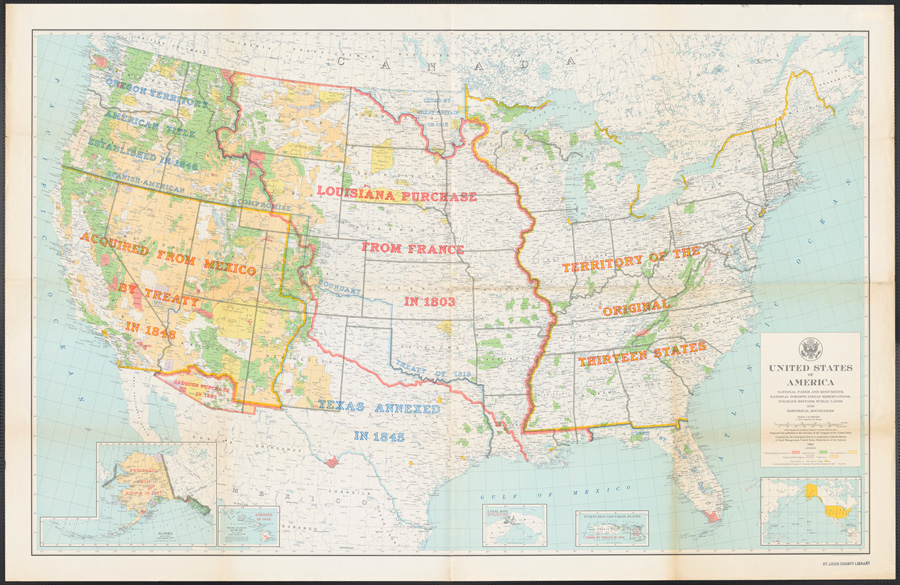“We’re digitizing our memories, we’re preserving them for future generations, but also connecting the dots and using the historical context to explain things. Not just filling out a chart. We’re more than birth and death and marriage dates. We all live lives.”
So says Brent Trout, Department Manager of the History and Genealogy Department of the St. Louis County Library (SLCL) since April 2022. The Clark Family Branch of the library system, which reopened in its new building in July 2024, now houses the Emerson History and Genealogy Department. One initiative of the department is building out the St. Louis County Library’s Digital Archive.
Earlier this year Anderson Archival’s Managing Partner Farica Chang connected with Kristen Sorth, the Director and CEO of SLCL through their mutual involvement in the Greater St. Louis Investors’ Council.
Learning more about the initiatives underway at the new Clark Family Branch, we asked SLCL what piece of their collection would make the biggest impact if digitized. The answer? Maps.
To learn more about how SLCL utilizes their digitized material, we sat down with Trout for a conversation about what goes on in the Department and how digitization makes a difference.
A Day in the Life of the History and Genealogy Department
“This is cliche, but no day is the same,” says Trout. The department currently has 13 employees. “We’re like a library within a library. We have our own catalogers, we have our own acquisitions, we have our own bindery, we have our public service folks.”
In addition to managing the day to day, desk shifts, and managing employees, Trout works with the library administration on long-range projects, developing new features. One of the crowning jewels of the Department is the Memory Lab, a space for the public to digitize their own material. Between helping patrons digitize, research and learn, the employees have anything but a stereotypical library job.
“The thing I love about genealogy is that it can help you feel connected. You can realize you’re not the only one in the world or you had family in these places experiencing the same things that we’re experiencing right now. Sometimes we deal with multi-generational trauma or conflict. Semi-regularly we will have adoption cases.”
-Brent Trout, Department Manager of the History and Genealogy Department of the St. Louis County Library
Discoveries can be wonderful, but the reality is that it can also be intense. A genetic geologist on staff may reveal an assault resulting in a different family line, or enslaved relatives. “We’re not here to pass judgements,” Trout says. “But they sometimes judge themselves or judge their families.”
The Memory Lab and Bringing Technology to an Aged Population
In the development of the Clark Family Branch, administration had an opportunity bring something new to SLCL. With literacy, computer literacy, and access being foundational goals of the library, a station where patrons could self-serve digitization made so much sense.
“I traveled around the country going to various examples of this, looking at what people were doing, and it was a wide variety too.” Some locations took a hands-free approach, providing the tools and a guide. Others seemed too hands-on. Trout determined that St. Louis County Library would find a happy medium. “We wrote detailed guides and we found the equipment where it would work the best for the demographic using our services.”
People came the first day. Since opening, the Memory Lab is at capacity 60-70% of the time. Perhaps that’s unexpected in genealogy, which is typically populated by our elders, with technology being used by people who have the least experience with it. Trout and his team are more than welcoming. “At this point we’re at 600,000 photos scanned,” says Trout. “We send out surveys every time someone uses the Memory Lab and the results are just staggeringly positive. One of the questions on our survey is, ‘Has your experience in the Memory Lab made you reflect on family history?’ It’s 100% always yes.”
“I want genealogy as someone’s grandmother did it to die. I want [the concept of] family history to take over for genealogy because it’s all a hobby, right? No one has to do family history,” Trout shares. “I see a lot of people who just want to fill out a family tree and I think that’s great. I welcome that. But I really want people to fill out that family tree and then learn the local history where their families were at.”
Part of that exploration happens in the Memory Lab.

Your History, St. Louis County Library’s Digital Archive
Before welcoming contributions to the Digital Archive by the public, Trout and his team knew firm guidelines needed to be in place. Primary point? Material needs to relate to local history.
“Well, what is local history?” Trout muses. “There isn’t a clear definition, especially for St. Louis. We’re St. Louis County, so is the Archive St. Louis County only? But things from St. Louis or St. Charles County have impacted us. We had to take the Clark Family Branch we’re at right now and draw a two-hour bubble around it. To us, that is local history.”
So far, SLCL isn’t actively soliciting local history materials for the Digital Archive, and to Trout’s surprise, few patrons consider the possibility that their collections might be of public interest. “We never want to be like, excuse us, we see you’re digitizing these materials. Can we have copies?” Something they couldn’t resist were slides depicting Clayton in the 1960s.
Solicitation of more material may be coming, but for now the most common offer from patrons is genealogy research, the keeping of which is not in the Department’s scope.
Material slated for inclusion in the Digital Archive is driven by several factors. “We have priority items that will shift around. We considered yearbooks to be the number one thing we were concerned about. We find yearbooks to be the impulse items of genealogy. If you can get someone who’s not into genealogy and show them what their parents look like, or grandparents, or whoever, they might think, ‘How can I learn more?’” Trout explains.
Primary contributors to the Digital Archive are Lauren Rhodes, Digital Collections Librarian, and two FamilySearch missionaries who operate on-site and donate 25% of their labor to SLCL requests. FamilySearch’s queue includes anything that SLCL would accept at 400 dpi (dots per inch) and Rhodes takes the rest, with a queue of over 1,000 items waiting to be digitized.
“We have a flow chart that we give all the staff,” Trout explains. “Is it a digital item? Or is it an item that needs to be digitized? Is this a digital donation or a digital loan?” A loan will jump to the top of the queue so the original material can be returned quickly. “Sometimes we have to adjust mid-queue.” A recent top priority item was issues of the St. Louis County Watchman Advocate, a frequently requested newspaper.
Once digitized and ingested into SLCL’s Digital Archive, the platform supports an interactive experience where patrons can tag people and add comments, all moderated of course. “We came to the game 20 years late for a digital archive,” Trout says. “But it’s because we don’t just jump into things. We want to make sure that we can keep something going once established.”
“We’re just opening a door,” Trout continues. “The door was shut beforehand. I think the thing that fuels us all is when we look at the numbers every month. Every month our numbers have gone up on the digital archive, with very little advertising. We’re turning into a virtual branch with a significant number of monthly visitors! Look at us! We have 3,000 people who just walked through our virtual door.” That door is opened all over the world through connection to the Digital Public Library of America.
Mapping St. Louis History with Anderson Archival
Once the opportunity arose, what brought SLCL’s map collection to the top of the queue? “One is the access. Maps are so valuable for doing research because of histories like ‘My ancestor came over in 1743 from Germany, hit Philadelphia, is gone for about 25 years in records, and then appears in Rowan County, North Carolina.’… When you pull out a map you can look and see ‘There’s the Great Wagon Road. That’s how he got there. What main spots are on the Great Wagon Road? There’s this place in Maryland, in Pennsylvania, in Virginia.’ If you don’t have a map in front of you, you’ll have no idea.”
Despite requests for the maps, they weren’t in Rhodes’ queue because SLCL lacked the internal equipment to digitize them. Enter Anderson Archival. “You went through the whole project way faster than any of us ever could have. It was a match made in heaven. The quality is incredible,” Trout says. “We’ve had other third-party people digitize things before and… you guys are really good. You guys are good at this.”

The Anderson Archival handled the maps with care and provided high-resolution images. In some cases, the original maps were too large to be captured in a single image. Utilizing specialized software and great attention to detail, the team merged images creating complete files. The end product is stunning, especially blown up and zoomed in.
“It’s so great to be able to go, hey, those are digitized. You can actually see this,” says Trout. “Being able to provide just this level of access is incredible. We have our digital archive, so we just toss it on there. We have these touchscreen monitors that we call our map stations where patrons can access them, enhance and blow them up, so they can actually see them.”
Since adding the maps to the Digital Archive over 100 people have accessed them. “That means we had 100 people who were just waiting for the opportunity,” Trout explains, compared to a good week in the Department when maybe two people would consult the maps. And being digital, the maps can be accessed without concern for wear and tear.
As digitized maps join the St. Louis County Library’s Digital Archive, they become another way patrons can experience family history. In Trout’s words, “Not just filling out a chart.”
Preserving the stories and experiences of history is at the heart of what Anderson Archival does. Those in the St. Louis area can take advantage of the Memory Lab to safeguard a variety of precious materials—but you don’t have to be local to benefit from Anderson Archival’s expertise. With a commitment to quality, care, and innovation, Anderson Archival ensures your historical documents and memories are protected for generations to come. Ready to preserve your own piece of history? Contact Anderson Archival today and discover how your story can live on.


